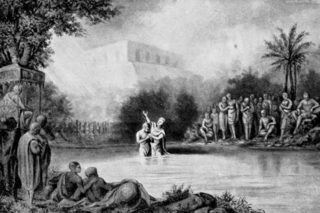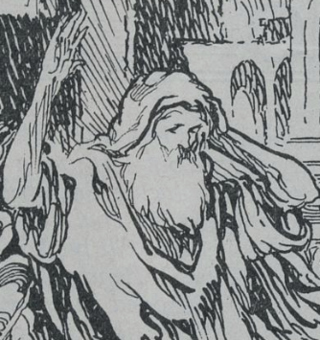The Book of Mosiah, probably written by Joseph Smith in the early 19th century, is one of the books which make up the Book of Mormon. The title refers to Mosiah II, a king of the Nephites at Zarahemla. The book covers the time period between ca 130 BC and 91 BC, except for when the book has a flashback into the Record of Zeniff, which starts at ca 200 BC, according to footnotes. Aside from stating that it was abridged by Mormon, the text says nothing about its authorship. Mosiah is twenty-nine chapters long.
The Book of Omni is one of the books that make up the Book of Mormon, a text that the Latter Day Saint movement regards as scripture. The book is written as the combined composition of several authors, the first of whom, Omni, provides the name of the book. According to the narrative, the book covers more than two centuries of Nephite history within one chapter of text. It refers to wars between the Nephites and Lamanites, the reign of Kings Mosiah and Benjamin, and their participation in the wars and journeys through the wilderness.

Zarahemla is a land in the Book of Mormon that for much of the narrative functions as the capital of the Nephites, their political and religious center. Zarahemla has been the namesake of multiple communities in the United States, has been alluded to in literature that references Mormonism, and has been portrayed in artwork depicting Book of Mormon content.

Alma is a Nephite prophet in the Book of Mormon. Initially a priest who serves in the court of King Noah, when a prophet named Abinadi preaches to the court Alma concurs with Abinadi and affirms that what the prophet said is true. For this, Noah banishes Alma and tries to have him killed. After leaving the court, Alma goes on to found a church among Noah's subjects. He eventually leads these churchgoers out from Noah's lands, through a sojourn under Lamanite rule, and to the land of Zarahemla, where their ancestors had come from a few generations earlier, where Alma becomes high priest of the Nephites' church.

In the Book of Mormon, King Benjamin, son of the first King Mosiah, is the second Nephite king to rule over Zarahemla. He is considered a king and a prophet and acts as both a spiritual and governmental leader. He is most associated with a speech to the people which begins in the second chapter of the Book of Mosiah and idealizes the life of a yeoman farmer.

King Noah is a Nephite king in the Book of Mormon who appears in the Book of Mosiah. Noah rules over a colony of Nephites who come from Zarahemla and settle in the land of Lehi-Nephi, succeeding his father, Zeniff. In the Book of Mosiah, King Noah distances from his father's teachings, committing what the text calls "all manner of wickedness." Noah and his priests sentence a prophet named Abinadi, who prophesies of his kingdom's downfall if they did not repent, to death by fire. During a Lamanite invasion, Noah and some of his people flee the land, and those who remain are subjected to Lamanite control. Noah attempts to forbid his men from returning to their families, and they burn him at the stake. Noah is succeeded by his son, Limhi.

In the Book of Mormon, Ammon is a prominent Nephite missionary and a son of King Mosiah. He originally opposes the church, but along with his brothers and Alma the Younger, is miraculously converted. Following his conversion he serves a mission to the Lamanites and converts Lamoni and his people.

Zeniff is a king in the Book of Mormon whose personal account is recorded in the Book of Mosiah. He is the father of King Noah and the grandfather of King Limhi. Zeniff is the first king of Nephite colonists who come from Zarahemla and settle in the land of Lehi-Nephi. These Native Americans believe this land to be rightfully theirs by inheritance, even attempting to reclaim the land by force. In an expedition in which he spies for the Nephites, Zeniff claims to see good in the Lamanite inhabitants. He argues against a militaristic approach and causes an internal battle among the Nephite army. Zeniff later leads a group of Nephites back to Lehi-Nephi and establishes a peace treaty with the Lamanite king whose people inhabit the land. Zeniff’s people prosper with him as king, but the Lamanite king betrays their treaty and attempts to exploit them. Zeniff and his people successfully fight off the Lamanites’ multiple aggressions, and Zeniff's reign lasts about forty years, after which he passes the kingship to one of his sons, Noah. Scholarly interpretations have highlighted Zeniff's shifting perceptions of Lamanites, such as how his opinion changes when his people contends with the Lamanites and the role that Zeniff's narration plays in racializing Lamanites in the Book of Mormon.

In the Book of Mormon, chapters 9 through 22 of the Book of Mosiah are identified as the Record of Zeniff. These chapters contain the story of a group of Nephites, led by Zeniff, who leave the land of Zarahemla and return to their former land, known as the land of Nephi, which was then occupied by the Lamanites, their traditional enemies. Although the attempt to establish themselves among the Lamanites is successful for a short time, the people of Zeniff are ultimately enslaved and forced to pay tribute to the Lamanite king. They are later rescued by an expedition from Zarahemla sent to discover their fate. The Record of Zeniff records the reigns of Zeniff, his son Noah and grandson Limhi. The timespan is approximately 75 years.

According to the Book of Mormon, the Anti-Nephi-Lehies were an ethnic group of Lamanites formed around 90 BC in the Americas, after a significant religious conversion. They made a covenant that they would not participate in war, and buried their weapons. Eventually they changed their name to the people of Ammon, or Ammonites. During a later period of warfare, the young men of the group who had not made the pacifist covenant became a military unit known as the two thousand stripling warriors, and were protected by divine intervention.
This article is a list of rulers in the Book of Mormon, including kings and chief judges among the Lamanites, Nephites, and Jaredites.

According to the Book of Mormon, the plates of Nephi, consisting of the large plates of Nephi and the small plates of Nephi, are a portion of the collection of inscribed metal plates which make up the record of the Nephites. This record was later abridged by Mormon and inscribed onto gold plates from which Joseph Smith translated the Book of Mormon after an angel revealed to him the location where the plates were buried on a hill called Cumorah near the town of Palmyra, New York.
This chronology outlines the major events in the history of the Book of Mormon, according to the text. Dates given correspond to dates in the footnotes of the Church of Jesus Christ of Latter-day Saints edition of the Book of Mormon and to a Jaredite timeline proposed by Latter-Day Saint scholar John L. Sorenson.

In the Book of Mormon, Mosiah, King Benjamin's son and Mosiah I's grandson, is king of the Nephite nation from about 124 BC to 91 BC. The Book of Mosiah is named after Mosiah. Mosiah is also a prophet and is described by Ammon as a "seer" who can translate records.

According to the Book of Mormon, Amaleki was a Nephite explorer who lived in the Americas in the 2nd century BC. He is mentioned briefly as one of the brothers of Ammon, and one of sixteen men that were part of Ammon's band. Under the direction of king Mosiah, the band embarked upon a quest from the land of Zarahemla to find the group of Nephites that had left years before to settle in the land of Nephi. Their exploration party wandered in the wilderness for 40 days before finally stumbling upon the people of Zeniff, who mistook them for Lamanite spies and threw them in prison. Ammon's band was eventually released and helped the people of Zeniff escape the occupation of the Lamanites and return to Zarahemla.

In the Book of Mormon, Ammon is a Mulekite descendant and leader of a Nephite expedition from Zarahemla, sent to discover the fate of Zeniff and his people. Zeniff and his followers left Zarahemla and travelled to Nephi, their ancestral home, which was then in the possession of the Lamanites. This may have contributed to his expedition, not knowing the actual route to Nephi.

The following outline is provided as an overview of and topical guide to the Book of Mormon:

According to the Book of Mormon, Coriantumr (/ˌkɒriˈæntəmər/) was a Nephite dissenter and Lamanite captain. Coriantumr led the Lamanite armies against the Nephites in an attempt to conquer the land. He was countered by Moronihah and Lehi, eventually dying in battle.








